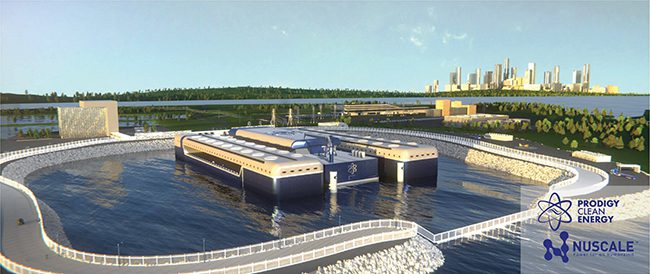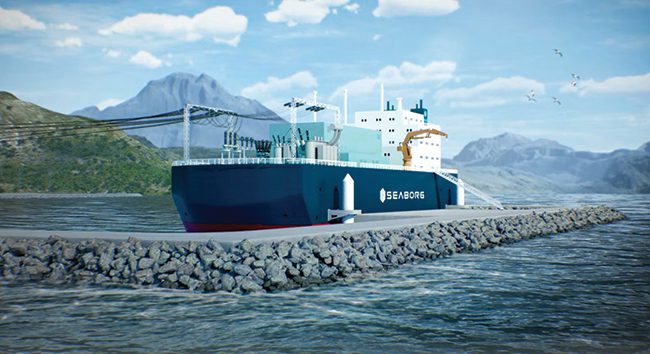Floating Nuclear Power Buoyant on New Prospects
In July 1968, the U.S. Army sent the world’s first floating nuclear power plant, the Sturgis, to the Panama Canal to help overcome a regional hydroelectric power plant shortage, which was driven by a severe drought and worsened by increased ship traffic through the Canal zone. The Sturgis (Figure 1) featured a 45-MWth/10-MWe MH-IA pressurized water reactor (PWR)—the last reactor the Army fashioned—and it operated until 1976, five years longer than initially anticipated. It produced 356 GWh until the military withdrew it from the area amid concerns that acts of violence might damage it during treaty negotiations between the U.S. and Panama.
 |
|
1. The Sturgis, a former World War II Liberty ship, was converted into the first floating nuclear power plant in the 1960s. Before being shut down in 1976, the Sturgis’ nuclear reactor, MH-1A, was used to generate electricity for military and civilian use in the Panama Canal. The very complex and unique MH-1A decommissioning project was ultimately completed in 2018. Source: U.S. Army Corps of Engineers |
While the Sturgis demonstrated crucial attributes of floating nuclear power—including reliability and resilience—it wasn’t readily replicated, despite emphatic efforts by industry, such as Westinghouse’s 1970s “Offshore Power Systems” initiative and Public Service Electric and Gas Co.’s 4.6-GW Atlantic Nuclear Power Plant. But buoyed by a global urgency to add new nuclear capacity to address modern power challenges, interest in floating nuclear power plants appears to be perking up.
A Key Selling Point: Flexibility
Floating nuclear’s key selling point is fixated on flexibility. Industry observers suggest emerging designs could accelerate the shift of the established paradigm for nuclear, which today is exclusively based on large centralized plants, toward distributed generation to satisfy multiple energy consumption needs beyond electricity, including heat, desalination, and production of hydrogen and ammonia.
In addition, experts note that nuclear mobility has been long established—and even predates the commercial nuclear industry—and fabrication methods already exist at scale at commercial shipyards. And, as the Electric Power Research Institute (EPRI) noted in a recent report, regulatory precedent has also been established by the 1970s Atlantic Nuclear Power Plant. “As part of this effort, the environmental and regulatory review processes for commercial offshore applications were exercised and demonstrated to the point of authorization of plant fabrication,” EPRI noted.
“Throughout the 1970s, a private-sector venture pursued state and federal regulatory review for the Offshore Power Systems proposal, which entailed multiple factory-manufactured floating reactors to be sited off the east coast of the United States,” it said. In the U.S., the regulatory review “was generally positive and resulted in a final environmental statement that included a recommendation for issuance of a license to remotely fabricate the nuclear plants in a purpose-built shipyard-like facility.”
Today, however, only one other floating nuclear power plant has been completed and deployed: Rosatom’s barge-mounted Akademik Lomonosov plant, which began supplying electricity and heat at Pevek, a remote mining site on the north coast of Siberia in May 2020. The plant includes coastal infrastructure and a floating power plant unit outfitted with two 35-MW KLT-40S thermal neutron spectrum PWRs.
However, more Russian projects are already on the horizon. Chinese shipyard Wison Heavy Industries in August 2022 kicked off construction for the first of four floating plants for offshore operation near Cape Nagleynyn in the Chukotka Autonomous Region. The project, which is slated to be moored in the Russian Arctic by 2027, will feature two Atomenergomash Group RITM-200S PWRs—a combined 105 MWe—mounted on a 140-meter-long barge.
“This project is special for us for several reasons: for the first time ever Atomenergomash establishes [itself] as supplier of the final product—floating power units, for which we are responsible from start to finish. Second, I can say that this is the start of the history of a whole [floating nuclear power plant unit] family, with a whole capacity and purpose range—Arctic and Tropic versions,” said Andrey Nikipelov, director general of Atomenergomash.
In North America, NuScale Power and Prodigy Clean Energy, a Canadian designer of small modular reactor marine power plants, in October 2022 announced a new conceptual design for their “transportable and marine-based small modular reactor (SMR) power generating facility,” which is based on NuScale’s terrestrial VOYGR power plant offering. The milestone marks the next pivotal step under a memorandum of understanding the two companies signed in 2018 to bring “a competitive North American SMR marine facility to market.”
 |
|
2. An artistic rendition of NuScale Power and Prodigy Clean Energy’s Marine Power Station. The companies in October 2022 said an updated concept would be used for engagements with utilities, regulators, and shipyard manufacturers. Courtesy: Prodigy Clean Energy |
Prodigy said its SMR Marine Power Station (MPS, Figure 2) can house from one to 12 NuScale Power Modules, for a total output of 924 MWe. “Compared to terrestrial deployments, the benefits of using Prodigy’s technologies to deploy the NuScale VOYGR SMR power plant begins with manufacturing and outfitting of the entire marine facility in a shipyard, enabling expedited delivery,” it added.
“Further advantages include a significantly reduced capital expenditure; accelerated project schedule; minimized site preparation; reduced environmental impact; unlocked project financing structures that are not typically available to conventional site-constructed nuclear plants; and simplified and expedited decommissioning and site recovery. The marine facility’s design is standardized to allow for deployment at a wide variety of sites and for serial manufacturing.”
Floating a Platform for Molten Salt Reactors
Development is kicking up for barge-mounted advanced reactor concepts, too, mostly in Asia. In December 2022, Bureau Veritas (BV), a certification body and also a nuclear power technology developer, announced it entered into an agreement with ThorCon for the technology qualification and “subsequent development” of a 500-MW molten salt nuclear power barge for operations in Indonesia.
The concept integrates a molten salt power plant within a floating barge hull, which will be towed to a shallow water site before being ballasted to rest on the seabed. “Experts from Bureau Veritas’ Nuclear Certification Department and from the Marine & Offshore Division will collaborate throughout the process,” BV said. “A key area of work will be to identify the applicable standards, codes and Class Rules, potential gaps with those currently available and the development if needed of new guidance notes and rules.”
BV anticipates the technology qualification process will take a minimum of three years. If successful, the deployment phase would require another two years. For ThorCon, which will focus on Southeast Asia as its primary market for its fourth-generation advanced nuclear design, technology qualification marks an important step. The company said it has entered into discussions with the Indonesian province of Bangka-Belitung, Indonesia’s state electricity company PLN, and the country’s nuclear energy regulatory agency BAPETEN regarding potential sites for the demonstration and the final installation of a 500-MW power plant. “Unlike current nuclear reactors, the ThorCon reactor operates at low pressure and uses liquid fuel. The liquid fuel enables much higher operating temperatures, leading to greater efficiency while also enabling completely passive safety (requiring no action from the operator nor intervention on the power source to stop the reaction),” it said.
Another floating nuclear liquid fuel concept separately making similar headway is spearheaded by South Korea’s Samsung Heavy Industries (SHI) and Danish technology firm Seaborg Technologies. In early January, SHI reported it had garnered Approval in Principle (AIP) from the American Bureau of Shipping for its Compact Molten Salt Reactor (CMSR) power barge. The AIP from ABS marks an essential milestone in a technology qualification process overseen by the global provider of classification and technical advisory services, essentially confirming that the proposed early concept complies with required industry codes and standards.
 |
|
3. Danish company Seaborg has partnered with Samsung Heavy Industries to develop the Compact Molten Salt Reactor (CMSR) Power Barge. “The CMSR Power Barge is designed to be cost-competitive, whether it’s delivering process heat for industrial purposes, electricity into the grid of an existing coal port, or power the production of hydrogen and ammonia,” Seaborg said. Courtesy: Seaborg |
The CMSR concept (Figure 3), which Seaborg launched in 2017, is a 250-MWth/100-MWe molten salt reactor designed for use in modular floating nuclear power barges. The concept derives from Seaborg’s first reactor design effort, the Molten Salt Thermal Wasteburner (MSTW), a terrestrial 270-MWth/115-MWe molten fluoride salt reactor, which features a graphite moderator.
“In these reactors, the molten salt is both the liquid nuclear fuel and the coolant that continuously circulates in a closed-loop primary system operating at or near atmospheric pressure. The reactor core is formed by an array of fuel/coolant pipes that pass through the moderator inside the reactor vessel,” Seaborg explained.
The CMSR, however, uses a “proprietary liquid moderator that enables the reactor core to be about 1/8 the size of a graphite-moderated core with a comparable power rating, such as the MSTW.” The scale is well-suited for marine applications, but so are the design’s inherent safety and refueling features, Seaborg noted. “Molten salt reactors are designed to be refueled online by periodically adjusting the amount of enriched uranium fluoride salt in the molten fuel/coolant to sustain near-term power operations. In an emergency, the entire inventory of molten fuel/coolant can be discharged from the primary system into criticality-safe drain tanks under the reactor,” it said. “In contrast, civilian marine PWRs contain enough enriched uranium to sustain operating cycles lasting from several years to a decade between refuelings. Marine PWRs severe accident phenomena may include hydrogen generation in the reactor core (from hot zirconium-water reaction) and core melt. These accident phenomena cannot occur in the CMSR.”
Seaborg’s concept is designed to be mounted on a flat bottom, unpropelled barge comprised of at least three modular sections: a bow, a power module housing two to eight CMSRs, and an “accommodation/control section.” Seaborg in April 2022 sealed a key partnership with SHI to manufacture and sell turnkey power plants “ready to be moored at industrial harbors and connected to the electric grid onshore.” The partners also launched an effort to develop hydrogen production and ammonia plants powered by CMSRs. However, they noted the design of these units “will be optimized for efficient serial construction at SHI’s shipyards.”
As a modular floating power plant design, the CMSR could deliver up to 800 MWe for a 24-year lifetime to developing countries strapped for power. “The site selection and facility constraints are relatively less demanding, the construction period is as short as about two years, and the cost is low,” the company claims. For now, SHI plans to commercialize the CMSR power barge by 2028, after completing the detailed design of all its power-generating facilities. Serial production could begin in 2030, it noted. The companies acknowledge that the timeline may be optimistic, given a lack of mature regulations that adequately address nuclear safety issues for the novel marine reactor design.
—Sonal Patel is a POWER senior associate editor (@sonalcpatel, @POWERmagazine).